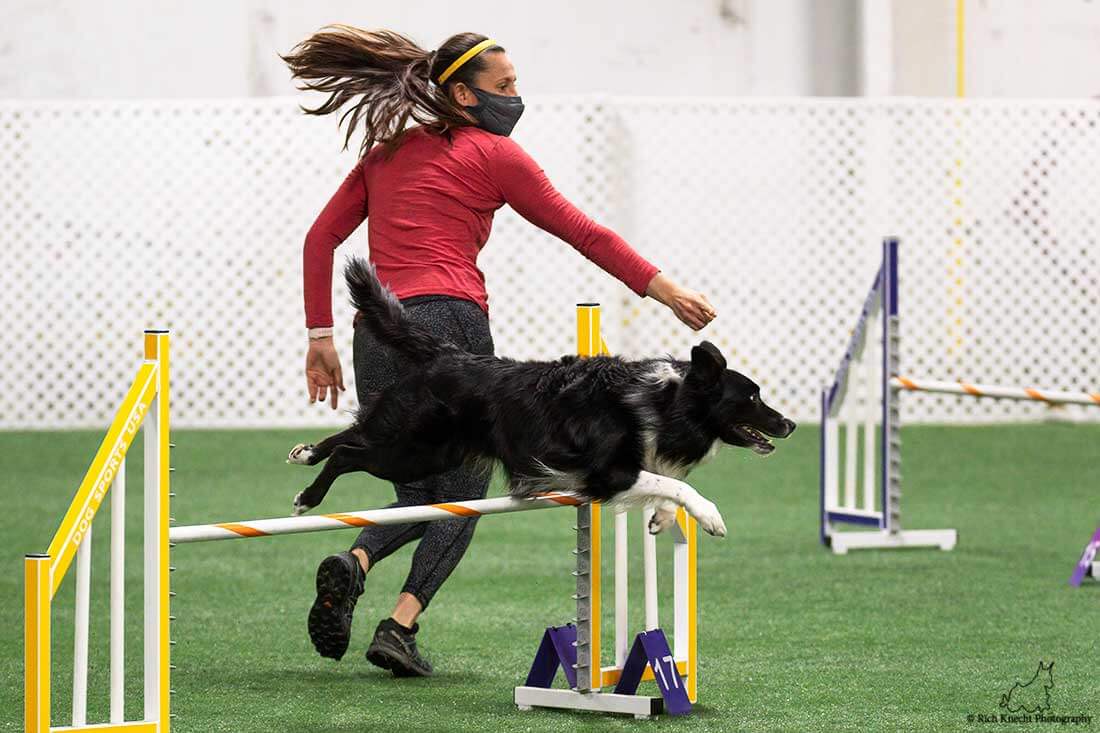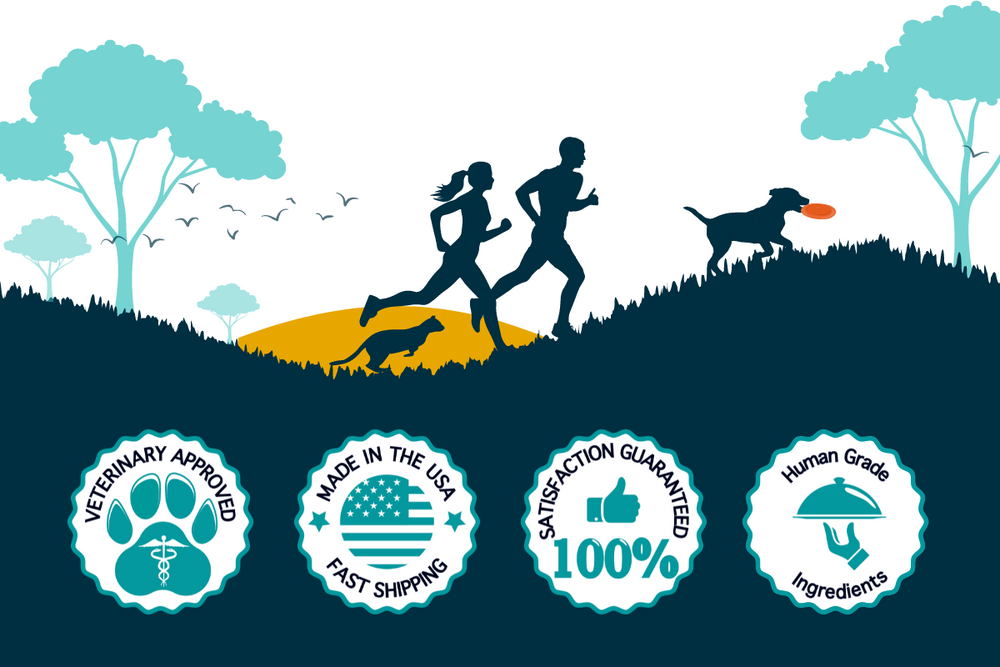Ask Anything Agility Q&A with Jessica Ajoux
It’s finally here! The live Q&A you’ve all been waiting for…
Do you have burning dog agility questions? Are you wanting to fill your brain with exclusive agility knowledge, tips, and tricks? Agility champion and Princeton graduate Jessica Ajoux is here to answer and discuss everything agility!
Introduction to Jessica
● We’ve done quite a few shows with Jessica, and there has been a lot of knowledge passed on. Since so many of you have had subsequent questions after each show, we decided to do a live Q&A with Jessica. A Q&A is often how she starts off her seminars to make sure that her audience understands what they need.
Click image below to see the entire live interview![]()
Question: When do you know your agility dog is ready for a competition for the first time?
● Big question! Definitely a lot of different opinions. Jessica thinks it depends on the dog, the team, and what you’re in the process of training. Many dogs will be ready to show in a jumper class or fast class or gamblers class before they’re ready to show in a standard class because certain obstacles could take longer to train.
● Jessica likes to expose her dogs to the show ring once she knows they know how to do the skills she’s going to ask them to do in the competition. They don’t need to be perfect and she’s not expecting to win the class their first time out. However, she does expect that she’s trained them correctly to prepare for the test. They’re educated, and they know what they should be doing.
● She’s had dogs she’s started at 15 months, but just because she is competing with them doesn’t mean she keeps them in competition. For example, when she brought Lu out at 15 months in standard and jumpers, it became clear that Lu shouldn’t do standard because she kept flying off the seesaw. Now the rules have changed so you can go back and fix things, but that wasn’t allowed at the time. Had she continued entering the trials with that repeated mistake, she would have been doing a disservice to her training and the dog’s career. Once the teeter got back under control, she entered Lu back in standard again.
● She likes to enter a trial or two and then not enter any to test how it’s going. Either you can’t wait until the next one because it’s going so well, or you realize the break was a good idea because they are young and may be all over the place in a trial situation.
● “When you believe they know their job adequately enough to be able to do it in public, it’s okay to enter the trial as long as you understand you might have to pull out of some of the trials in order to assess what’s been happening at the competition.”
● You don’t want to rush the dog; you want to take your time. You’re learning as you’re preparing the dog. You want to react to what the dog is doing. Again, just because you started competing doesn’t mean you have to keep going.
● On the flip side, with Optimus, Jessica had him take a year-long break from competition. She decided to retrain his A-frame and dog walk, and she couldn’t enter him during that period. Why would you enter a dog into competition when a dog doesn’t know how to do a piece of equipment that will be tested in that competition? She doesn’t think it’s right to test something that is still in the process of being trained. She didn’t want to pull him for that long, but it is what was required in that situation.
● A motto Jessica follows is “teach them how to swim before you throw them in the deep end”.
Question: When is the best time to give your dog a 1TDC: before the agility trial, during the trial, after the trial is over, or what if it is a couple day trial?
● Jessica doesn’t do anything differently. She gives her dogs 1TDC in the morning typically because that is when she gives her dogs all of their supplements. She keeps that system the same during a trial, making sure she travels with it if they are having to travel for competitions. You can use it for pinch moments like if they have cut a pad, so she keeps it on hand for moments like that just in case.
● From a 1TDC standpoint, I agree. When you’re in the moment of competition, do not change your dog’s routine because there is already enough going on.
● From a dosage standpoint, athletic dogs tend to go into a loading dose prior to competition, especially if they’re older, ages 5-6 and up.
● 1TDC promotes healthy inflammatory responses, so when they’re building up a lot of lactic acid in competition, if your dog pulls something, you can use it topically.
Question: At what age do you start giving 1TDC to a puppy?
● You can start 1TDC at virtually any age. With a puppy, we recommend you start once the adult teeth are in. But since it’s completely preventative at that age, you can technically start at any time, and you don’t need to do a loading dose.

Question: What can I do about flanking? Physical and verbal cueing is not always enough.
· Flanking is referring to a herding dog’s tendency to go out wide. If you are trying to get them to come into you, the herding dogs often want to go out and around because that is bred into them in order to catch sheep. Useful in herding, frustrating in agility.
· Before it’s happening, if you start to see your dog making a curve when you want them to go straight, even in foundation exercises, Jessica recommends doing it against a wall or a fence to where they can’t actually go out wide because of that barrier.
· Be careful that you are maintaining good connection, if you are not- they can become confused. You may want to look where you’re going, but that bobblehead motion is not good for them. It can promote them wanting to flank.
· Make sure not to let them cut behind you. If you are looking for them to come to one side or the other, and they start going behind you to come to that side, do not look for them on that side, following them over there. It’s like undoing your cross.
· Some pre-placed rewards along the path could help. With flanking, they’re sometimes not sure where they are supposed to go, or they don’t even realize they’re doing it. Making the answer so clear by putting the reward along the path to indicate where they should be going can help minimize that tendency. Dogs are not usually trying to be inefficient, so if they clearly know where they are going, via the preplaced toy, it can help them go in a straighter line.
· Make sure to teach them how to be able to operate close to you as the trainer. Think about agility heeling, doing circle work, like if you are running, and you have trained your dog to stay at your side and not cut in front of or behind you. This used to be more popular. It’s essentially a “HERE” command for dogs who have the tendency to cut in front of or behind you.
Question: What skills might an older person (late 70s/early 80s) need to run agility with a pretty fast dog and be somewhat successful?
· You definitely can be successful, do not limit yourself due to age or physical ability. It is all possible. The price is training. The more independent the dog must be in order to cover the course, the more training you will have to fit into it.
· You have to have the start line stay, and it must be reliable to where they are not pushing you, and to where you could go anywhere on that course without it shifting. Without it, it’s not going to happen.
· The next skill would be the independent obstacle skills. Call to, send, run by, peeling off on your leads and your contacts. Jessica would expect that teaching stop contacts across the board would be the way to go. You could maybe do running A-frame, but depending on the course, that would be more or less difficult to manage.
· They should have a rear cross, being able to turn away from the handler. Jessica also likes teaching them the opposite end of the tunnel cue, which is a newer idea. That would make things easier.
· She thinks that even with less running, you can still do the international style challenges. Then you need very independent back side skill and a threadle skill, and the abilities to do them at a great distance. Know that you do not actually need to be close to your dog for them to execute the skill; this will just take more training.
· Finally, you must have the “Go On” cue for all courses.
Question: Are you training differently with Empower & Genuine (her new puppies) than you did with Lu & Wit?
· The difference between how she’s training this new generation and the middle generation is not as drastic as the difference between the middle generation and the oldest generation. Now they are just refining the systems.
· Teaching independent verbals and skills such as the back side and threadle cues is similar to what she just mentioned as an older trainer, is key. The big thing that they are doing is emphasizing the dog’s verbal recognition earlier on in the training. The first things they were learning were sit, down, and stand. Rather than just luring, they focused on them being able to do those skills with no help, only the verbal, in the effort to get them to pay more attention to the words that people are actually saying. That is really hard. Some dogs are more skilled at this than others. The point is what comes out of Jessica’s mouth is going to matter.
· The other thing they have implemented now is the instructional releases. If she is giving instructions, it’s expedited training for their understanding things. Check out the release word video that we did with Jessica last year.
· They’re going to experiment more with using guide wires for weave pole training. They have previously used Weave-a-Matics and channel poles and 2x2 weaves to train the weave poles. If you ask four different agility trainers how they train weave poles, you will get four different answers.
· I’ve always appreciated how Jessica never says that she knows something for sure. She is always driving to improve and to learn more. We are clearly the benefactors of that learned experience and continued experimentation. Agility is constantly involving, and she is driven to stay as ahead of the curve as possible.
Question: We moved recently and lost access to our long-time coach and training facility. Is it possible to keep my eight-year-old springer in competition body condition with only access to a couple jumps and weaves? Or should we postpone competition?
· That’s super sad, but that happens sometimes. But now you have to get creative. As an eight-year-old dog who has already been trained in agility, you don’t necessarily need to train things in agility. The dog has the skills. It’s more about maintenance, keeping the dog sharp about their skill level and keeping them in the right physical shape to do agility well.
· As long as the dog is getting good exercise (walking, hiking, other conditioning steps), not very much access to agility is okay. If you are competing more weekends than not, they are getting a lot of exercise, so you don’t have to train as much.
· You can be creative in setting up small sequence. Make sure that agility is not the dog’s only source of conditioning. Off-leash hiking is the best. On-leash hiking is okay, too. Walking around the neighborhood if you don’t have hiking. Come up with other ways to keep them in shape.
· The lack of access to agility won’t hinder the physical shape; it might detract from some of the contacts and maintaining other behaviors. But the dog may not need that. Dogs don’t usually forget too much as long as you can get some sporadic access here and there.
· Jessica would rather not do heavy training with some of her “older” dogs. At five, she is trying not to still be training stuff. Whatever she’s trained is in there, and now it’s about maintenance and good physical conditioning. She did retrain Optimus’ dog walk at three, and she’s glad she didn’t do it at six years of age.
· That happened to Fame later in her career. Agility evolved faster than she was willing to train her, so she retired her from international because she did not want to drill and train Fame enough in order to keep her at that pace. She could still compete in other avenues of agility. Some of her young dogs have been trained in different skills as a result. Fame is now retired at age 10 even. Though she is in good shape, Jessica made this decision because she is not putting in enough agility conditioning to allow her to keep doing agility safely. She is not in the top physical shape that she was when she was Jessica’s #1 agility dog. It would be dangerous for her to be put on an agility course without upping that training.

Question: How do you increase flexibility in your dogs?
· All dogs are built differently, just like all people. Jessica has always been able to reach her toes with no problem no matter the shape she’s in. But ask her to sit cross-legged, and her knees are at her ears. There are limits that each “body” naturally has.
· Some dogs can bend their spine more naturally than others. Some dogs can collect and turn well without bending as well. And other dogs can’t bend at all. Because of this, Jessica doesn’t worry too much about flexibility. She takes note of what they do well naturally and works more on what they need more for.
· She’s not trained as a physical therapist, but she does know through her agility training what her dogs’ natural motions look like.
· If she is trying to increase flexibility to make a good turn on a jump, for example, she would take note of which direction her dog more naturally turns and make dedicated training sessions to the less strong direction. She would lower the bar and start at the level of getting the type of turn she wants.
· Jessica stresses for trainers to remember that some skills are physical skills. Jessica understands what a one-handed pushup is, but she can’t do one no matter how much you yell at her. She can’t physically do it. If she works on it, conditioning the body to get better at it, starting with a two-hand pushup, then picking up her hand during the pushup one time, she will improve. But it will take time. Remember this for your agility dogs.
· She brings her dogs to an Advanced Canine Rehab every month to have the peace of mind about her dogs being in good shape. This way she stays on top of their physical wellbeing. Therefore, if she is seeing a bad turn, she knows they’re not hurt, and she can safely ask them to do it. It’s not fair to insist training something if there is an injury involved there.
· It can be difficult for some dogs to run A-frame. If you have one who understand what you’re trying to do but can’t physically do it, it could be because they’re not in the condition to do it. Or they don’t have the flexibility. You have to work on these things very gradually, just like how you may have to work your way up to running a marathon. It’s all about the increments, and it can take a lot of work to achieve a certain condition.
· Jessica did water polo in high school and college and has remained active. She’s 35 and has noticed a difference in her skill level despite the maintenance. In her own experience of feeling something in her back, she knows what she has to do, and she knows if she doesn’t do it, she will eventually get hurt.
· Dogs are the same way as they age. The older they are, the longer they are on leash and warm up before she lets them go. You have to warm up the body and cool it down before and after exercise. They can’t go from crate to running a course. It may work in the short term, but you will pay the price in the long term.
Contact Jessica
● UnitedDog Agility on Facebook, Instagram, YouTube









